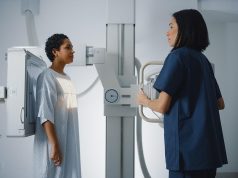Bioimpedance spectroscopy monitoring with early interventions lowers need for aggressive treatment
FRIDAY, May 4, 2018 (HealthDay News) — For breast cancer patients undergoing treatments that are high risk for the development of breast cancer-related lymphedema (BCRL), evaluations with bioimpedance spectroscopy (BIS) allows for early detection of BCRL that is responsive to conservative interventions, according to a study presented at the annual meeting of the American Society of Breast Surgeons, held from May 2 to 6 in Orlando, Fla.
Lyndsey Kilgore, M.D., from the University of Kansas Health System in Kansas City, and colleagues evaluated 146 breast cancer patients with unilateral disease undergoing treatments that are high risk for the development of BCRL. Patients with subclinical lymphedema diagnosed by a BIS result of two standard deviations above baseline from preoperative assessment were started on at-home conservative interventions (compression sleeve garment and self-massage).
The researchers found that 34 percent of patients developed subclinical lymphedema, identified by elevated BIS scores, and were initiated on self-directed treatment. At last follow-up, 82 percent of these patients had resolution of elevated measurements. Nine patients had continued elevated measurements and were referred to outpatient complete decongestive therapy (clinically persistent BCRL incidence, 18 percent). On final surgical pathology, patients with persistent BCRL had significant nodal burden; eight of the nine had N2 or N3 disease. Six of these nine patients have died due to breast cancer.
“Early detection with patient directed interventions for subclinical and early lymphedema can improve patient outcomes and decrease the risk of chronic irreversible lymphedema,” the authors write.
Copyright © 2018 HealthDay. All rights reserved.








